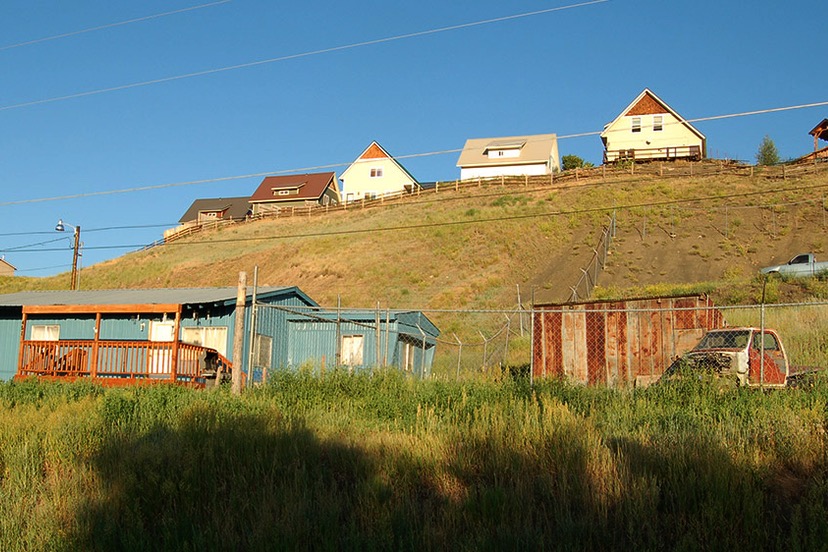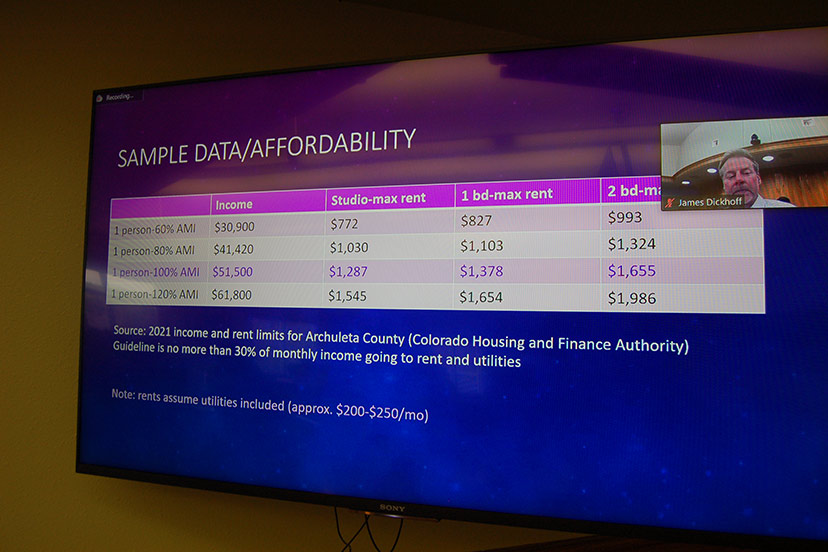Two funny things happened when I was writing Part Five of this editorial series on Friday.
While looking for a decent photo to illustrate the article, I chanced upon a photo I’d used back in April, when Town of Pagosa Springs Community Development Director, James Dickhoff, was delivering a report to the Council regarding rents in our community— in particular, the rental rates the Town presumably wanted developer Servitas to ‘hit’ with their proposed 98 apartment and townhome units. Since we (the taxpayers) were giving them free property, and apparently guaranteeing payment of the mortgage ($75 million) and also granting them sole right to manage (and profit from) the project for the next 50 years… presumably they would build something that met our needs. Rather than their needs.
The goal, in April, appeared to be ‘workforce housing’. That would be, to my mind, housing for the people working in our various local industries. The people who do the heavy lifting, you might say, to keep the economy moving.
In the photo from April, Mr. Dickhoff showed the maximum Archuleta County rents allowed in CHFA (Colorado Housing and Finance Administration) housing projects, at various AMI (Area Median Income) levels. The rents, as you can see, ranged from $827 a month to $1,654 a month, for a one-bedroom apartment. The rent would depend upon the worker’s annual income.. or at least, that seemed to be the general idea.
In other words, an average rent of about $1,240, for a one-bedroom.
One might assume that Servitas was paying attention? Maybe they weren’t. Or maybe we have somehow slipped — without noticing — into an alternate reality.
When, on November 1, Servitas showed the Town Council their proposed rents for their one-bedroom apartments, the range was from $1,315 to $2,591.
Not an average of $1,240, but rather, an average of $1,953 per month… for a one-bedroom apartment, measuring about 584 square feet.
We were probably justified in laughing out loud, except it was not actually funny.
But I thought it was funny that I’d accidentally found that photo from last April.
And it’s funny how much things can change in just 6 months.
The other funny thing on Friday, was an early-morning email from a Daily Post reader that included a link to an online Colorado Sun article, titled, ‘Western Slope voters overwhelmingly passed taxes on short-term rentals to fund affordable housing’.
Votes living in the western half of Colorado have decided that Short-Term Rentals are not only a significant problem, directly related to the housing crisis… they are also a convenient source of tax revenue when you propose the idea to the voters.
I found it funny, because — on Tuesday — I had addressed the Archuleta Board of County Commissioners at their regular meeting, and suggested that they consider putting a substantial excise tax on STRs, and using the money for roads and housing. It seems pretty obvious, I told them, that the voters are not interested in a sales tax increase… but voters all across Colorado seem open to excise taxes on vacation rentals.
Here are some of the pertinent results from the November 8 election, as cited by Jason Blevins in the Colorado Sun:
- Aspen voters approved an additional 5% to 10% tax on short-term rentals that will deliver about $9.1 million a year for affordable housing.
- Carbondale voters approved a 6% excise tax on short-term rentals to generate $400,000 a year for affordable housing.
- Chaffee County voters approved the reallocation of lodging taxes from purely tourism promotion to include workforce housing and child care…
- Dillon voters approved two measures: a 5% excise tax on short-term rentals and a 6% excise tax on all lodging that will raise about $4.5 million a year for affordable housing. Dillon voters also approved $20 million in debt to buy, plan, develop and maintain workforce housing.
- Durango voters approved the city’s request to retain revenues from a 2021 lodging tax increase for affordable housing…
- Eagle County voters approved a new 2% lodging excise tax on short-term rentals in unincorporated areas and Gypsum, with 10% of the $3 million in new revenue going toward tourism promotion and 90% to fund housing and child care.
- Glenwood Springs voters approved an additional 2.5% lodging tax to generate $2.5 million a year for workforce housing.
- Gunnison County voters approved the reallocation of a 4% local marketing district lodging tax, with 40% for “tourism-supporting” projects like housing, child care and recreational infrastructure and 60% for tourism marketing and promotion.
- Salida voters passed two measures increasing annual and nightly taxes on STRs to create a funding source that could support the construction of 29 new affordable housing units per year.
- Snowmass Village voters approved the reallocation of a 2.4% lodging tax from tourism to workforce housing.
- Steamboat Springs voters approved a 9% tax on about 3,000 short-term rentals to raise $14.3 million for the first phase of development of a planned 2,300 units.
- Summit County voters approved an additional 2% excise tax on short-term rentals to raise $5.4 million a year for affordable housing and child care with 10% of the new revenue supporting “social, cultural and environmental uses related to local tourism.”
With a bit of encouragement, our BOCC could consider similar funding streams and dedicated uses. New taxes in Colorado must be approved by the voters, so any proposal from the BOCC would have to wait until next November. But the campaign, and the effort to build community involvement, could start immediately, echoing the way the Archuleta School District engaged the community many months before their successful mill levy override vote.
In the meantime, the County has a moratorium in place, prohibiting new STR permits to be issued. It appears from the data shared on AirDNA.com, that we currently have about 1,256 active STRs in the 81147 zip code, with an average daily rental rate of about $230, and an average rental income of about $3,065 a month per STR.
If these numbers are accurate, then our total STR industry is currently generating about $3.8 million a month, or perhaps $46 million a year. If they were contributing a 10% tax to our community — paid, of course, by visiting tourists — that could conceivably provide $4.6 million in revenue.
Rvenue that could be used to address our two major problems here in Pagosa Springs: bad roads, and unaffordable housing.
Is that something our BOCC and Town Council could get behind?
With some encouragement from the taxpayers?



